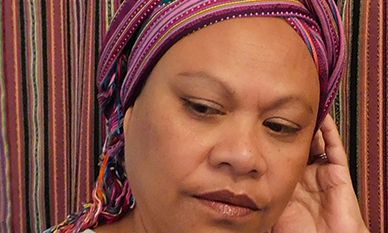Traditional materials provide Maria Madeira with a “sense of belonging” Dennis Philip Irwin
Twenty-five years since East Timor voted for independence from Indonesia, Timor-Leste has made its debut at the Venice Biennale with Maria Madeira’s Kiss and Don’t Tell at Spazio Ravà, a venue overlooking the Grand Canal in the San Polo district.
Evacuated from Timor to Lisbon in 1976, Madeira and her family immigrated to Australia in 1983 where she completed her schooling and went to Curtin University in Perth. Returning to Timor-Leste in 2000 to teach art in the capital, Dili, Madeira was relieved to find “Timorese culture still very much alive”, she says. Faced with a shortage of art materials, “you have to go overseas to get them”. She credits Timorese materials, such as tais (a traditional Timorese cloth) and betel nut (an iridescent-coloured tropical fruit), with not only providing her with a “sense of belonging”, but also a method to “bridge the gap” between traditional and contemporary art. “[Using traditional materials] my art can reach both Timorese and Western international communities,” the artist says.
The pavilion features large-scale works on tais emblazoned with marks made from betel nut, natural pigments and a performance that explores “trauma, hope and healing”. For visitors it will hopefully be “like walking into one of her paintings”, says its Australian-based curator, Natalie King.
First conceived late last year by the Australian author Kim McGrath and the gallerist Anna Schwartz, Timor-Leste’s participation in Venice could have easily been derailed if not for the support of the country’s prime minister, Xanana Gusmão (who is also a painter and acclaimed poet), and president, José Ramos-Horta. “They did everything possible to make this happen,” Schwartz says.
“Timor-Leste has just been embraced [by Venice]” says King, who curated the pavilions for New Zealand in 2022 and Australia in 2017. And while there are clear synergies between Madeira’s experience as a refugee and Adriano Pedrosa’s Strangers Everywhere theme, another factor is the “goodwill around Maria”, King says. “She’s been instrumental in supporting Timorese arts and culture”.

